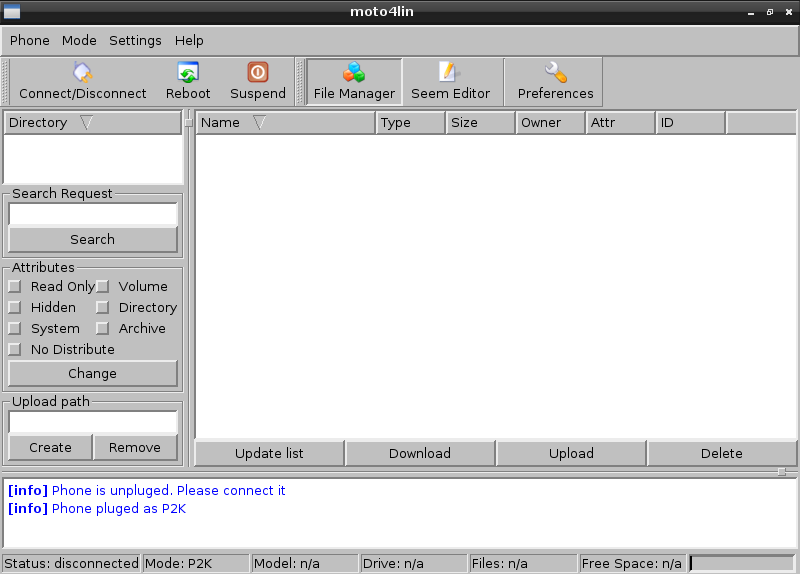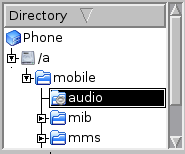Moto4lin is a Linux tool for browsing the filesystem and
performing raw configuration value edits (known as "Seem edits")
on old Motorola P2K phones. This outdated tool depends on some
deprecated libraries not distributed anymore by most Linux
distributions, hence why the usage of an old distro release is
required. Debian was chosen due to their long-term archival of
packages for their obsoleted releases. The 6 (Squeeze)
release was the last one to provide the required dependencies.
For this guide VirtualBox was used. When creating the
virtual machine, make sure to provide at least 512 MB of RAM and 4
GB of disk space, which should be more than enough for this task.
Network access worked out of the box with VirtualBox's virtual "Intel
PRO/1000 MT Desktop" adapter.
For convenience, here's how the Debian installation procedure was
performed while making this guide (for a non-graphical installation):
- The LXDE desktop environment was chosen.
- When prompted for a hostname, leave the default value.
- When prompted for a domain name, leave it empty.
- Set up users and passwords as you desire.
- The "Guided - use entire disk" partitioning method was used. Keep in mind this will remove all data (if any) from the virtual disk. The "all files in a partition" mode was chosen.
- A network mirror was not used. You may get an error past this step, ignore it.
- Both "Graphical desktop environment" and "Standard system utilites" were installed. (use the Tab key to select the OK button)
- Grub was installed to the MBR.
- Reboot!
After finishing the installation and rebooting, make sure you
have removed the CD image from the virtual drive so that the VM
won't boot again from it.
If sucessful, you will be greeted by a login screen on your
freshly installed system. Log in as the standard
(non-administrator) user, then open a terminal with administrator
privileges by running Start Menu > Accessories
> Root Terminal. You will be prompted for the system
administrator's password. We will perform most steps from here.
Since this Debian release is very outdated, their package
repositories are no longer hosted at the main Debian package
servers, but at the archive.debian.org server. We have to manually
fix this before we can proceed downloading any additional packages
on the machine.
For this, open the /etc/apt/sources.list
configuration file with a text editor of your choice (For
beginners, you can use Leafpad, a simple graphical text
editor. To open a file with Leafpad, execute leafpad
"path/to/file" as a command. For example: leafpad
"/etc/apt/sources.list")
Append the following line at the end of the text file: deb
http://archive.debian.org/debian/ squeeze main contrib
and append a # to the beginning of any line starting with "cdrom"
to disable them.
Now, exit the text editor and execute apt-get update
to download the package lists. If sucessful, you will come across
the following:
Fetched 6,699 kB in 4s (1,373 kB/s) Reading package lists... Done W: GPG error: http://archive.debian.org squeeze Release: The following signatures were invalid: KEYEXPIRED 1520281423 KEYEXPIRED 1501892461The error at the end is due to the GPG keys used to validate the integrity of the files having expired long time ago. This will also cause the package manager to ask whether to "install packages without validation". For this task you can ignore and accept them.
apt-get install moto4lin The Zip tool for creating ZIP archives will come in handy later,
too. Install it with apt-get install zip
If the VM display is at a resolution lower than 1024x720 (You can
check it out at Main menu > Preferences > Monitor Settings)
You will have to tweak QT3's appearance config for the moto4lin
window to fit on the screen. Execute apt-get install
qt3-qtconfig to install the configuration tool. Now open
it from Start Menu > Preferences > Qt3
configuration. Go to the Fonts tab, and set the main
font to DejaVu Sans, point size 10. Save with File
> Save and exit.
Execute moto4lin with root privileges from the
terminal.

Now, enter the Preferences menu. Connect your phone to your
computer and enable the USB passthrough feature to have it passed
to the VM. Wait a few seconds and click on Update List.
Your phone should appear on the list. Select it and click on Set
as AT Device, then Switch to P2K mode. This sends a
USB Mode switch command, that will make your phone disconnect and
reconnect as a different USB device, with its P2K interface
exposed. For this reason, you will have to enable USB passthrough
again. Wait a few seconds and update the device list again. The
Product ID should change. Select it again and now click on Set
as P2K Device, and save the configuration with Ok.
Now connect to the phone toggling the Connect/Disconnect
option on the top bar. If sucessful, [info] Phone connected
as P2K should appear on the info bar. Now get the
directory listings with Update List. A directory tree
should appear.

You can expand the directories to reach its subdirectories, and
select them to list their files. (Tip: On some models, J2ME apps
are stored in the /a/mobile/kjava/installed
directory)
Now you can select any file(s) (Use Ctrl to select multiple
files) and use the Download option to read and store them
to your VM.

Pack the files in a Zip archive by starting Start Menu
> Accessories > File Manager, then browse to
the folder where the desired files are. Select them and Right
Click > Compress. Name it and set archive type to Zip.
If you have an external FAT32-formatted USB drive, an easy method
is installing the Thunar file manager (apt-get
install thunar) and using the USB
passthrough feature. Once installed launch it from Start Menu
> System Tools > Thunar file manager.
Passthrough the device and it should appear at Thunar's left bar.
Copy the desired files and don't forget unmounting the volume when
finished for safe extraction (Right click at the device at the
left bar > Unmount Volume)
The system also comes with an "outdated" web browser (Iceweasel,
rebranded Firefox) which you can still use with simple file sharing
websites without too many Javascript bloat and forced HTTPS.
Original release: 20-December-2020
/ Last edited: 17-July-2021
GIF animations from a Motorola C450 menu icons and screensavers
Thank you for reading <3